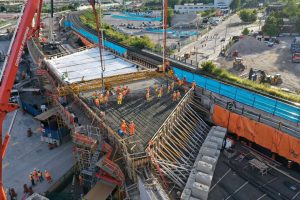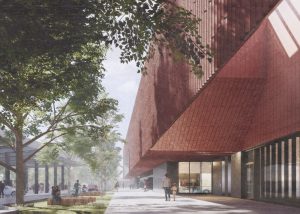With a population of more than 200,000 people and growing, the Jewish community in the Greater Toronto Area is rapidly expanding. This has led to a need to renovate its existing community centres and to develop new centres.
With a population of more than 200,000 people and growing, the Jewish community in the Greater Toronto Area is rapidly expanding. This has led to a need to renovate its existing community centres and to develop new centres.
Having renovated the downtown Miles Nadal Jewish Community Centre ($10 million), and built the Wolfond Centre for Jewish Campus Life ($4 million), the UJA Federation of Greater Toronto is in the midst of its $350 million Tomorrow Campaign that will result in the completion of the 27.5-acre Sherman Campus in North York and the 50-acre Joseph and Wolf Lebovic Jewish Community Campus in Vaughan.
The Vaughan Campus, which is currently undergoing construction, will cost about $150 million.
The UJA Federation broke ground for the $150 million Sherman Campus (on Bathurst, north of Sheppard and adjacent to the Don Valley Ravine) last October.
“The Sherman Campus will be home to Jewish organizations and agencies and have a mix of cultural, educational, athletic and recreational activities that will be available to community members from all cultures,” said David Sadowski, the senior project director. “This is the largest non-profit infrastructure project in the country. The site currently houses the Bathurst Jewish Community Centre (JCC), Koffler Centre and the Leah Posluns Theatre, which will be completely re-built, and the Lipa Green Building for Jewish Community Services, which will undergo a major renovation.”
Mansoor Kazerouni and Sol Wassermuhl of Toronto-based Page Steele Architects, who recently won several awards for the Rose Theatre in Brampton, are designing the Sherman Campus.
The campus’s facilities will be fully integrated and linked with each other by open exhibition areas and gallery walkways. This was developed as an extension of the ravine’s lush environment. The anticipated completion date for the Sherman Campus project is fall 2011.
The campus’s new buildings will include:
•The Prosserman JCC, a 70,000-square-foot state-of-the-art athletic, social and recreational facility, which will replace the Bathurst JCC.
•The 500-seat Leah Posluns Theatre, to be rebuilt with cutting edge technology.
•The Koffler Centre for the Arts, which will offer theatre, arts education, music, dance, film, spoken word, literary programs and an extensive gallery of changing exhibitions.
•The National Centre for Jewish Heritage, which will include the new Holocaust Centre of Toronto Museum, library, Ontario Jewish Archives and museum exhibits that reflect the Jewish experience.
In terms of renovations, the Lipa Green Building for Jewish Community Services will undergo a complete refurbishment and renovation, including a conference centre that can accommodate over 300 people.
The construction of the Prosserman JCC and renovation of the Lipa Green Building are scheduled to begin this April. UJA is currently in the tendering process for the Prosserman JCC and the Lipa Green Building and contracts should be awarded in early March.
Phase II of the construction will begin in June 2009. This will see the completion of the Centre for Health and Wellness at the Prosserman JCC, Leah Posluns Theatre, Koffler Centre for the Arts and the National Centre for Jewish Heritage.
The tenders for Phase II will be issued in the spring of 2009.
The design for the Sherman Campus is highlighting many green initiatives.
“The design team is maximizing the impact of its green initiatives by adopting sustainable design principles in the site design, building design and building systems,” said Sadowski. “The Campus will incorporate leading edge technologies and building automation systems to reduce energy costs. Design features include heat recovery systems in the swimming pools and washroom exhaust systems, white roofs to reduce the urban heat sink impact of the buildings, storm water retention for use in site irrigation, and occupancy sensors to shut lights when rooms are empty.”
As well, green space will be recovered by limiting the amount of surface parking spaces. The campus will have approximately 450 underground parking spots and other design aspects will reduce runoff into the neighbouring Don River watershed.











Recent Comments
comments for this post are closed